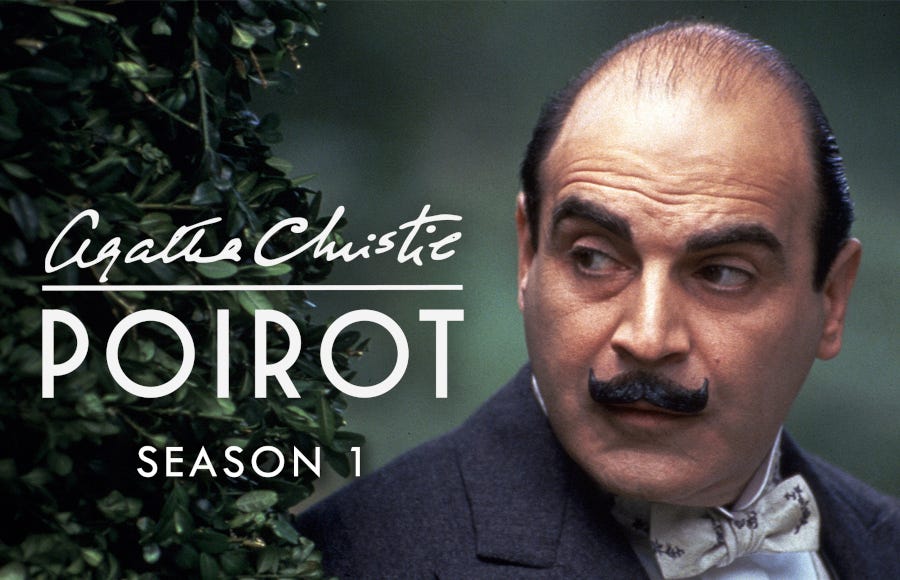Stream On! ‘Poirot’ a monumental collection of Agatha Christie tales
The neatness of Poirot’s attire was almost as incredible as his little grey cells.
I’m reading a biography of Agatha Christie, in which the author mentions an important Christie character, the “Actively Detecting Reader,” that is, the audience, who are given all the clues needed to solve each of her mysteries—unless the protagonist of the story solves it first. The protagonist in Christie’s first novel, The Mysterious Affair at Styles, was a formidable Belgian World War I refugee living in London, private detective Hercule Poirot.
/Streaming /Amazon /★8.6/10 /Trailer /1989-2013 /TV14
From the producers of Agatha Christie's Marple and Agatha Christie's Partners in Crime came Agatha Christie's Poirot, which included dramatizations of every Hercule Poirot story, even ones like Murder on the Orient Express and others that have already been given big-money big-star Hollywood treatments.
And against some great actors who have played Poirot in movies and on TV—Albert Finney, Peter Ustinov, Kenneth Branagh—I will put up my winner, the star of Agatha Christie’s Poirot, David Suchet.
Poirot is introduced in the novel The Mysterious Affair at Styles (set in 1917) as “an extraordinary looking little man. He was hardly more than five feet, four inches, but carried himself with great dignity. His head was exactly the shape of an egg, and he always perched it a little on one side. His moustache was very stiff and military. The neatness of his attire was almost incredible. I believe a speck of dust would have caused him more pain than a bullet wound.”
And after seeing Suchet as Poirot, to watch anyone else in the role would cause me some pain—and I can conjure only his image as I read the stories. Suchet is totally Poirot, imbued with a solemn dignity sometimes leavened by a strange sense of humor that not everyone gets, just as Poirot finds others’ humor incompréhensible. As a Belgian, Poirot is a Francophone with an accent in English, who still sprinkles French words into his discourse.
“Yet this quaint dandified little man who, I was sorry to see, now limped badly, had been in his time one of the most celebrated members of the Belgian police. As a detective, his flair had been extraordinary, and he had achieved triumphs by unravelling some of the most baffling cases of the day” (Styles).
The first episode of the first season is not “The Mysterious Affair at Styles,” Christie’s first novel, because in 1974 she released a collection of Poirot’s Early Cases, a prequel, if you will, to the canon. The TV series episodes are all set in the 1930’s with the exceptions of “The Mysterious Affair at Styles” (1917) and “Curtain: Poirot’s Last Case” (1949). But every ‘Hercule Poirot’ story is here.
Like Sherlock Holmes’ companion Dr. Watson, Poirot’s friend Captain Arthur Hastings (Hugh Fraser, Game, Set and Match) narrates many of the stories in print, and in print is a mildly unreliable narrator. He works for Poirot in the latter’s detective agency, along with Poirot’s clever secretary Felicity Lemon (Pauline Moran), out of Poirot’s apartments in a stunning Art Deco building across from a London park.
As if the audience needed more encouragement to watch, these sets are beautiful, a festival of Art Deco, and so are the costumes and 1930’s autos: catnip for the Actively Detecting Audience; also rewarding for the casual viewer.
Sources include Wikipedia (Creative Commons Attribution-ShareAlike 4.0 License)
Pete Hummers is a participant in the Amazon Services LLC Associates Program, an affiliate advertising program designed to earn fees by linking Amazon.com and affiliate sites. This adds nothing to Amazon's prices. This column originally appeared on The Outer Banks Voice.




